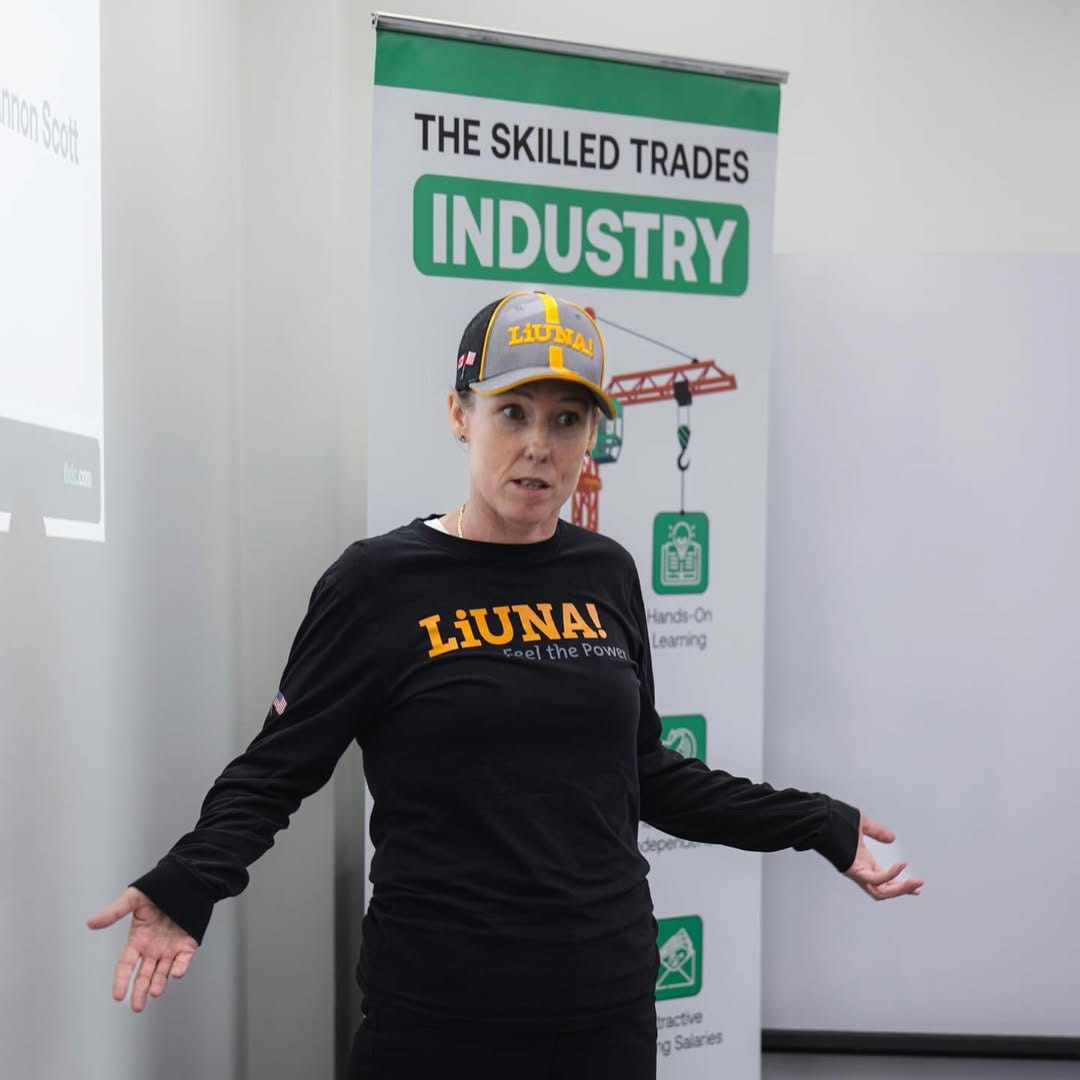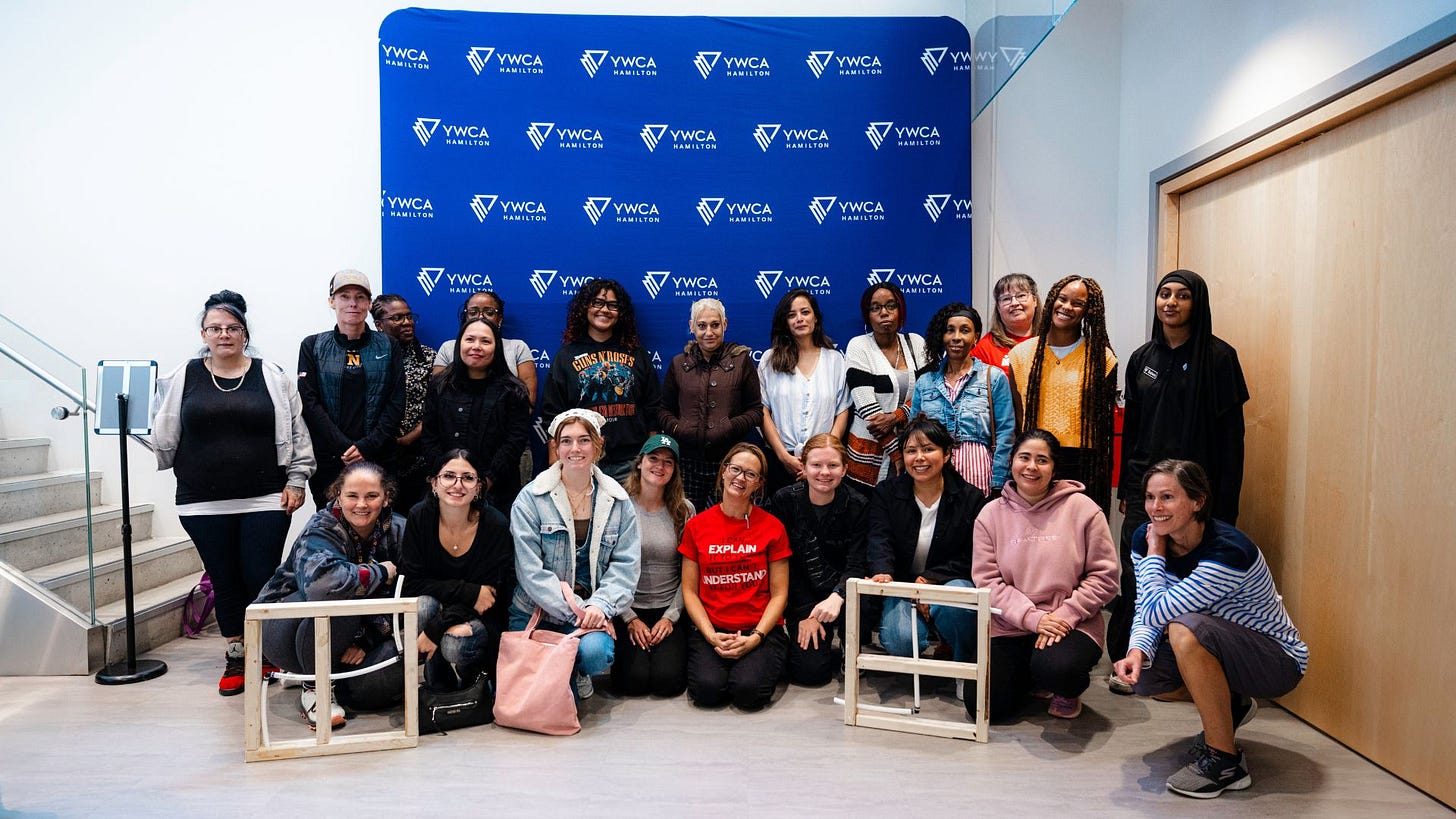Breaking Into Canada's Skilled Trades: A Starter Guide for Newcomers in Ontario
Canada needs 700,000 trades workers by 2028.
Please forward this to ONE friend today and tell them to subscribe here.Bottom line: Canada needs 700,000 trades workers by 2028, and the construction and manufacturing industries are expected to be the hardest hit. Toronto and the wider province of Ontario are also in the midst of a construction boom which means lots of opportunities for newcomers willing to get their hands dirty. Entry-level positions start at $18-25/hour, with clear paths to increase earnings through apprenticeship levels, Red Seal certification, and specialization.
The cranes tell the story. Toronto currently leads North America with the highest number of construction cranes in operation. Drive through the city and you’ll see them everywhere—skeletal giants assembling the residential developments, mixed-use developments, hospitals, and the public infrastructure that come with the demands of one of Canada’s fast-growth regions.
Each project needs electricians, plumbers, carpenters, HVAC technicians, welders. And they are getting desperate. The federal government estimates that roughly 700,000 trades workers may retire between 2019 and 2028.
In Ontario and the GTA, this pressure is particularly acute: major infrastructure projects, transit expansion, and residential development place high demand on electricians, plumbers, HVAC technicians, industrial mechanics, carpenters, and other trades.
Though the pipeline of new apprenticeships is improving, many municipal and regional institutions report challenges in scaling training to match employer needs.
The Misconceptions Keeping People Out
“Trades are only manual labour.” Many believe trades are just physical work. But modern trade increasingly involves technology, problem-solving, design, and the use of advanced tools. Electricians work with building automation systems. HVAC technicians use digital diagnostic tools to troubleshoot repair complex heating, ventilation, and air conditioning systems. Tradespeople use and Building Information Modeling (BIM) for project planning. You might still need a shovel, but you’ll also need tablets.
“There’s no career growth.” Skilled trades offer clear pathways, from apprentice to journeyperson to foreperson, site supervisor, or even business owner. Wages are competitive, and many trades are in such demand that they provide long-term stability. Wages also increase with each step. And many tradespeople eventually run their own contracting companies.
“It’s not a field for newcomers or women.” There’s a misconception that trades are dominated only by Canadian born men. In fact, programs across Ontario actively encourage newcomers and women to join. And many employers are eager to diversify their workforce.
Shannon Scott believed this too.
In her mid-40s, after COVID-19 derailed her TV production career (CBC Sports, ESPN’s NBA Finals), she found herself depressed and rethinking everything. She’d always wondered about working in the trades but felt intimidated.
“I live beside a construction site and see these guys work. And I’m like, why can’t I do that? But being a woman, I was scared. I was intimidated.”
She researched programs for women in trades. Found one. Applied. Got accepted. The training transformed her. “This program by TBDC not only equipped me with practical skills but also boosted my confidence. I wasn’t looked at as a woman. I was looked at as a potential worker.”
After graduation in October 2024, she earned an apprenticeship seat that kicked off in March 2025, where she’ll work toward her Red Seal certification, a nationally recognized credential that seemed impossible months earlier.
Now, with the support of Toronto Business Development Centre (TBDC), LiUNA 837, and the Ontario Government, she advocates for other women entering the trades, often thinking of her 10-week-old granddaughter. “I hope that one day, if she chooses to enter the trades, she won’t have to experience what I did and that’s why I’m here.What Your Day Actually Looks Like
A plumber usually starts the day by reviewing work orders and traveling to job sites, where they diagnose issues such as leaks or clogs, and install or repair pipes, fixtures, and systems. Their work also involves testing water pressure or drainage, ensuring compliance with safety codes, and completing paperwork before heading to the next call.
An electrician, on the other hand, begins with safety checks and reviewing wiring diagrams or blueprints. Their responsibilities include installing, maintaining, or repairing electrical systems, outlets, and panels, as well as troubleshooting issues using tools like multimeters. Once the work is complete, electricians test systems thoroughly and document their results.
The work is structured but varied. And you are rarely required to stare at a screen for eight hours or more.
The Learning Path Is Not As Complicated As You Think
Pre-apprenticeship programs (3-6 months): These programs make you employable. You’ll split your time between classroom study and hands-on training, learning fundamentals, safety protocols, and tool operation. In the GTA, reputable training institutions include George Brown College, Humber College, Sheridan College, and specialized trade schools.
The TBDC Explore Skilled Trades program is designed specifically to support newcomers, providing pathways into apprenticeships, hands-on workshops, and connections to employers. Government-funded programs like those offered by TBDC provide participants with training, equipment, certifications, support, and PPE, all free of cost. Other organizations, including Employment Ontario providers, offer similar programs where participants receive comprehensive support at no expense.
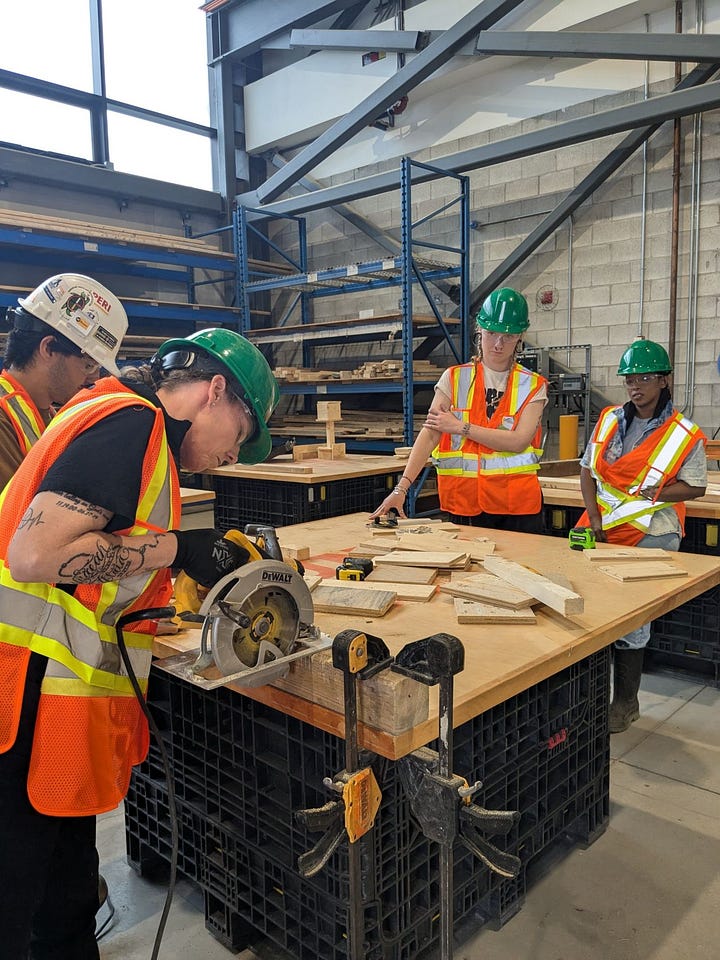
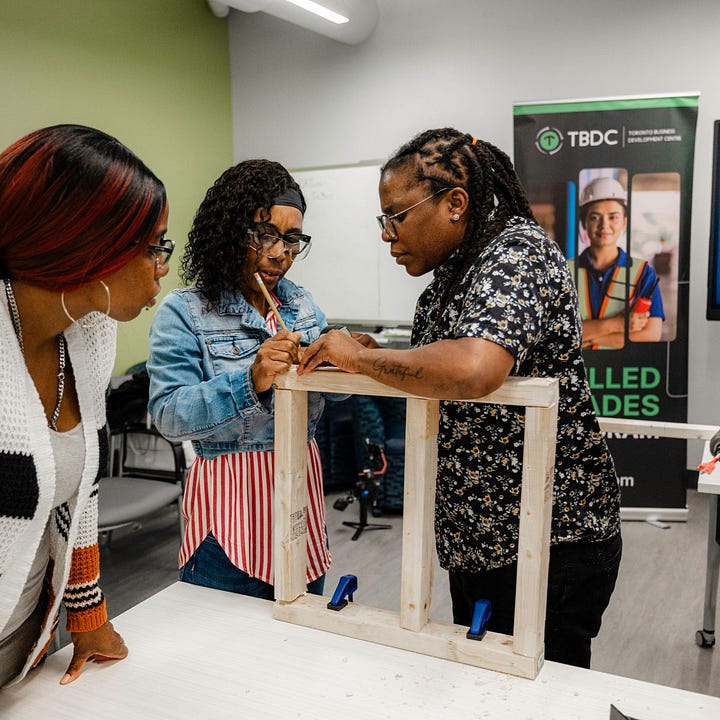
Apprenticeships (2-5 years to reach high earning potential): The work is split between classroom learning and on-the-job training under a licensed journeyperson. You’ll gradually take on more complex tasks while garnering the required hours. This means you’re earning while building real skills on actual job sites.
Day-to-day, as an apprentice, you’ll shadow experienced professionals, practice daily routines, and build skills through repetition and feedback until you’re confident and independent.
Certifications: Most trades require completing an apprenticeship and passing the Certificate of Qualification exam; the Red Seal endorsement which provides national recognition. It also offers a strong return on investment as it opens you up to opportunities across Canada—you can work anywhere in the country with the Red Seal.
The Most Accessible Entry Points as a Newcomer
If you have zero experience, you have four main pathways into the trades:
1. Pre-apprenticeship or introductory skilled trades programs. These are specifically designed for people with no background. You learn the basics in a low-pressure environment before stepping onto a real job site. The environment is supportive, mistakes are expected, and the pace allows you to build confidence gradually.
2. General labour or helper positions on construction sites. You won’t be doing specialized work immediately, but you’ll be around tradespeople, learning the culture, building your network, and understanding what different trades actually involve. Many successful tradespeople started as general labourers and discovered their specialty by watching others work.
3. Entry-level warehouse, logistics, or delivery roles leading into trades. These positions familiarize you with the industry’s rhythm and demands. They often lead to opportunities for further training, specially in larger companies that promote from within.
4. Starting as an apprentice directly. If you can find an employer willing to take you on, you can begin earning immediately while learning on the job. This is the fastest path but also the hardest to access without connections or prior experience.
Your Potential Career Progression
Start as an apprentice: You’re learning the basics, following instructions, doing the simpler tasks while watching experienced workers handle complex problems.
Become a journeyperson (2-5 years depending on trade): You’ve completed your required hours and passed your certification exam. You can work independently, take responsibility for projects, and mentor newer apprentices. Your earning potential increases significantly.
Advance to foreperson or site supervisor: You’re managing projects, coordinating teams, ensuring safety compliance, and handling logistics. This role combines technical expertise with people management and administrative responsibilities.
Start your own business: Many tradespeople eventually become business owners, running contracting companies, hiring their own teams, and building something they control. This path requires business skills beyond technical expertise, but the earning potential is unlimited.
Specializations at any stage add value. An electrician who learns solar installation or smart home systems becomes more valuable. An HVAC technician certified in energy-efficient systems can command higher rates. A welder with specialized certifications for industrial applications opens doors to high-paying projects.
How Much Do You Make?
Entry-level: Around $18-25/hour as a general labourer or first-year apprentice. At 40 hours per week, that’s $37,440-$52,000 annually.
Mid-level: Around $28-35/hour as a mid-level apprentice or junior journeyperson. At 40 hours per week, that’s $58,240-$72,800 annually.
Pay increases are really up to you. Complete another level of your apprenticeship, your rate goes up. Earn your Red Seal, it goes up again. Specialize in high-demand areas like green energy and industrial trades, it continues climbing.
Many eventually own their own contracting businesses, where earning potential is determined by how much work you can take on and how well you manage your operations.
How benefits work: Skilled trades are often unionized, providing health, dental, pension, and training fund benefits. Non-union companies may still provide extended health and vacation pay.
Barriers Newcomers Face (And How To Overcome It)
For newcomers, the most significant barriers to entering the skilled trades are the lack of Canadian work experience, navigating apprenticeship pathways, and the costs or time commitments of training.
Beyond that, hidden hurdles include understanding union systems, safety regulations, and finding mentors who can guide them through the process.
Language barriers can make it difficult to understand technical instructions or communicate on fast-paced job sites. But support from bilingual supervisors, visual training materials, and government-funded programs like TBDC’s Explore Skilled Trades help bridge the gap.
Credential recognition is another challenge. Foreign training and experience aren’t automatically recognized in Canada. Newcomers can apply through Skilled Trades Ontario to have prior training and experience assessed. Bridging or upgrading programs like TBDC’s Explore Skilled Trades help fill gaps and guide them toward certification.
Cost and time present real obstacles. Training takes months, and many newcomers need income immediately. Government-funded programs address this by providing training, equipment, certifications, and PPE all free of cost.
Where Are Opportunities Growing The Fastest?
Before you commit to years of apprenticeship training, understanding where the industry is heading is an important first step.
Green building: Solar installation, energy efficiency retrofits, renewable energy systems, and sustainable construction methods. As Canada pushes toward climate goals, trades linked to clean energy and green infrastructure are growing rapidly. Key trends include the rise of sustainable construction, energy-efficient retrofits, and smart building systems.
Automation and industrial mechanics: Combining technical expertise with new tools is the new deal. Tradespeople who can operate drones for inspections, use Building Information Modeling (BIM) for project planning, or work with smart building systems are increasingly valuable.
Residential construction: The GTA’s housing crisis isn’t resolving soon. Carpenters, electricians, plumbers, and HVAC technicians will remain in high demand for years.
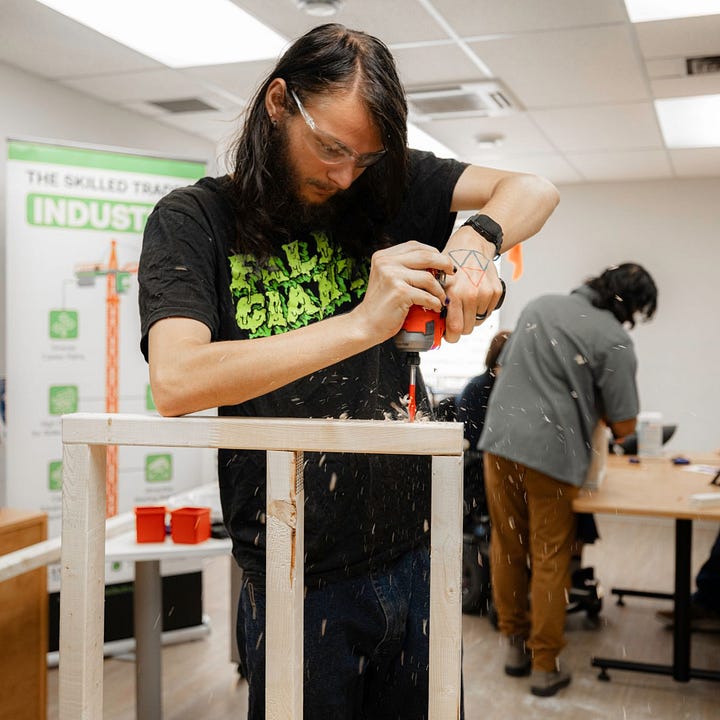
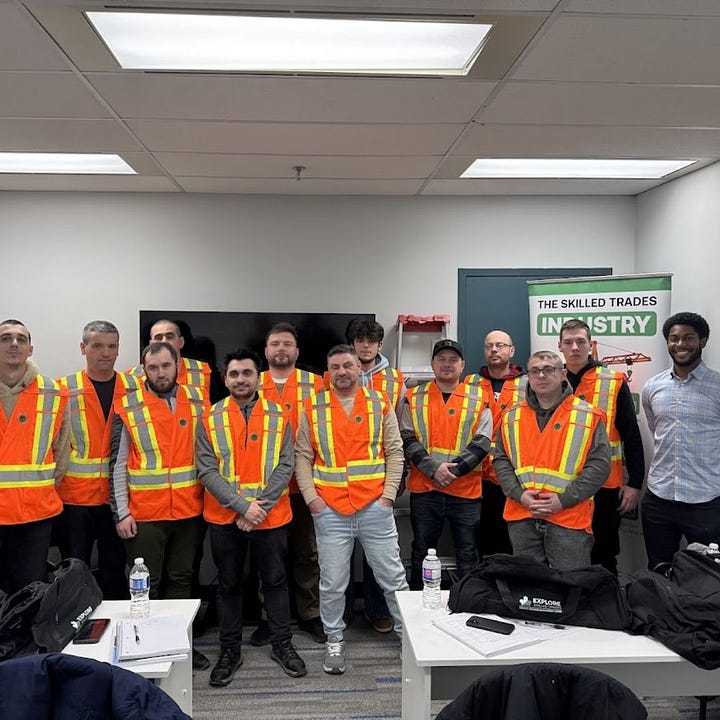
Geography Matters When Planning Your Trades Career
In the GTA, there are more projects—and therefore more job opportunities—than in any other part of Ontario. Toronto’s construction boom creates consistent work for tradespeople across all specialties. You can be selective about which projects you take, which employers you work for, and which specializations you pursue.
The downside is a higher cost of living plus longer commutes if you’re working on multiple job sites.
As the province develops more 15-minute cities to ease the strain on the GTA, opportunities are expanding in regions such as Windsor, Thunder Bay, Ottawa, Kingston, Hamilton, and Barrie. Project managers often prefer to hire locally to reduce workforce travel, which creates openings for regional talent.
Living in smaller cities can mean more affordable housing and lower daily expenses. But the challenge is often securing steady, consistent work compared to the GTA. You might have fewer projects available, longer gaps between jobs, or less ability to specialize in niche areas.
Some tradespeople choose to live in more affordable regions and travel to the GTA for work, while others prefer to stay local and accept the higher costs for the convenience and consistent opportunities.
How To Find Work
The best resources to find job openings include Employment Ontario job banks, union postings, industry associations like the Ontario General Contractors Association (OGCA), and community organizations. TBDC’s Explore Skilled Trades program also connects participants directly with employers and apprenticeship pathways.
To stand out, your resume and cover letter must highlight hands-on experience, certifications, and soft skills such as teamwork and reliability. Explain what you learned, what you built, what problems you solved.
Make sure to ask potential employers about apprenticeship opportunities, mentorship, and long-term growth prospects. Many newcomers overlook these questions. Also ask about typical project timelines, safety culture, opportunities to learn different aspects of the trade.

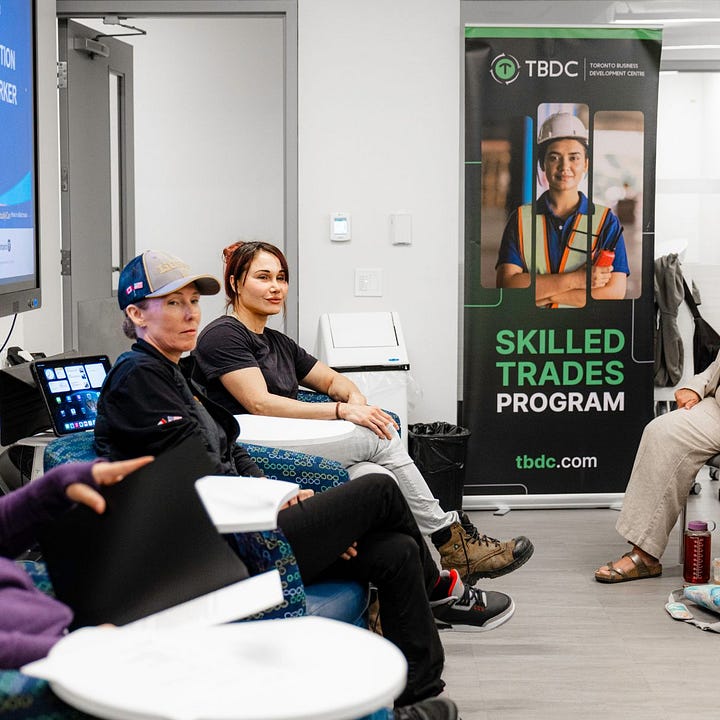
What To Do After Reading This
If you’re serious about exploring these careers, start by connecting with your local Employment Ontario provider or industry associations such as Skilled Trades Ontario, Skills Ontario, and Merit Ontario. All of these organizations host regular events and bootcamps where participants can network, learn, and even try simulators
You can also reach out to Mustafa at TBDC (mustafa@tbdc.com) or join one of TBDC’s upcoming events. TBDC offers a wide range of resources to help you learn more, and attending one of the Industry Trips is a great way to gain firsthand insight into what a career in these fields looks like.
Or you can explore a pre-apprenticeship program at George Brown College, Humber College, or Sheridan College.
Frequently Asked Questions
Which trades are most in-demand right now? Electricians, plumbers, HVAC technicians, carpenters, and welders are experiencing the most acute shortages across the GTA.
How long before I’m actually earning decent money? Pre-apprenticeship or short training gets you employable in 3-6 months at $18-25/hour. Full apprenticeship takes 2-5 years to reach $28-35/hour.
Do I need to speak perfect English? No. Many job sites in the GTA are multilingual environments, and programs offer bilingual support and visual training materials.
Can my foreign credentials be recognized? Not automatically. Apply through Skilled Trades Ontario to have your prior training assessed. Bridging programs help fill gaps without starting from scratch.
Are there grants or loans for training? Government-funded programs like TBDC’s Explore Skilled Trades provide training, equipment, certifications, and PPE free of cost. Employment Ontario providers offer similar support.
What’s the physical demand really like? Expect heavy lifting, working in tight spaces, outdoor conditions year-round, and long hours during project deadlines. The industry emphasizes strict safety standards and mandatory PPE.
Is the work steady or seasonal? Construction, repair, and maintenance happen year-round. Infrastructure and housing projects make most trades recession-resistant, though new construction can slow during downturns.
Do trades offer good work-life balance? It varies. Project deadlines create pressure and long weeks (50-60 hours), but the work ends when you leave the site. You don’t take work home.
Can I start my own business eventually? Yes. Many tradespeople become business owners after earning Red Seal certification and gaining several years of experience. You’ll need to register a company, secure insurance and licenses, and invest in tools.
What are red flags in training programs? High upfront fees, no recognized credentials, hidden costs, poor safety records, and limited job placement support. If it sounds too good to be true, it probably is.
What are green flags in training programs? Government funding, partnerships with reputable employers, clear certification pathways, and MTO or provincial approval.
Which roles are becoming more valuable with technology? Electricians who understand smart building systems, HVAC technicians trained in energy-efficient systems, and anyone who can operate drones for inspections or use BIM for project planning.
Should I live in Toronto or a smaller city? Toronto offers more consistent work and specialization options but higher living costs. Smaller cities like Hamilton, Kingston, or Barrie offer lower costs but fewer projects and longer gaps between jobs.
What should I test before fully committing? Attend information sessions and industry field trips to experience the physical demands, hours, and work environment before investing in licenses or training.




